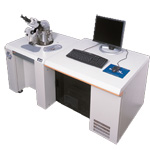【DISCONTINUED】JSPM-5400 Scanning Probe Microscope
DISCONTINUED

This product is no longer available.
If you would like to know the latest information about your preferred product or to find out more about alternatives, please click on the link below. We hope you will continue to use our products.
The JSPM-5400 comes with versatile measurement modes.
The addition of options for each measurement mode extends measurement capabilities.
Features
New Non-Contact AFM
Smple, Quick, Safety
Safety high-speed approach
Damage-less scan control
Simple positioning
Safety operation with shortened time until observation process
Fine
High resolution imaging without damage using Non-Contact AFM
Environmental Control
Stable observation of heated/cooled samples in high vacuum
Versatile Measurement Modes
The JSPM-5400 comes with versatile measurement modes. The addition of options for each measurement mode extends measurement capabilities.
Safety high-speed approach
Using a two-step approach (high-speed and fine approach: patent applied for), the cantilever can rapidly approach the sample without damage.
Since high-speed approach is possible without collision, this method is effective for samples scattering lights highly and transparent samples, which are difficult to provide the distance between their surfaces and a cantilever.
Safety high-speed approach detects weak gravity, which acts as long-range gravity, away from the sample. The cantilever can approach the sample at a high speed (up to 50 m/sec) until the weak gravity is detected. After the high-speed approach ends, fine approach is performed while the distance between the cantilever and the sample is controlled.M The safety high-speed approach ends in a short time, enabling one to start the fine approach without worrying about the distance between the sample and the cantilever.
Fast, simple positioning
The skip-scan function, incorporated in the JSPM-5400 as a standard configuration, shortens measurement time since the number of pixels for images can be reduced.
Damage-less scan control
Damage-less scan control is used to operate the probe within the limited area (L in the top image) with respect to the standard surface (point A in the top image). When observing the edge of cross-sections, you can safely scan the probe without collision between the apex of the cantilever and the edge.
Since a function that automatically renews the standard height is incorporated, the JSPM-5400 can automatically set the standard point in the upper direction of the concave portion even for samples with steep concavity (patent applied for).
This function allows measurement of even samples with unknown topographic shapes, without damage.
Since damage-less scan control is very effective for measuring near the edge, this function is useful for imaging cross sections created by a cross-section preparation device, CP (Cross Section Polisher®). (See the figure to the lower.)
Probe auto tracking
This function automatically corrects the vertical drift caused by thermal expansion and contraction of sample during heating/cooling observation, preventing the apex of the probe from contacting or getting away from the sample surface over a long time. Continuous imaging under temperature variations (see the bottom images in page 3) utilizes this function.
(To heat and cool the sample, additional accessories are needed.)
Excellent environmental control
Drastic improvement of the structure of the SPM head increased the vacuum quality. Using an optional cold trap system, the vacuum pressure reaches the order of 10-6 Pa. Thus, gas adsorption on the sample can be reduced to a minimum amount, maintaining a clean sample surface.
It is possible to align the optical axes of laser lights to a cantilever and a photo detector for the SPM detection system placed in the vacuum, even from the outside of the vacuum.
By attaching a vacuum evacuation system and an airlock sample exchange mechanism, you can exchange a sample while maintaining the vacuum, and also can shorten the time from sample setting to observation.
Specifications
| Resolution | Within surface: 0.1 nm, Vertical direction: 0.01 nm
AFM: Atomic resolution (mica with the contact mode) STM: Atomic resolution (HOPG atomic image) |
|---|---|
| Measurement mode(AFM) | NC mode (frequency detection)
Topographic image, Frequency shift image, Dissipation image (Option: SKPM, MFM, EFM ) AC mode (amplitude detection) Topographic image, Phase image, Amplitude image (Option: Viscoelasticity image, SKPM, MFM, EFM) Contact mode Topographic image, Force image, Contact current image, FFM (Option: Viscoelasticity image, LM-FFM, PFM, SCFM) Spectroscopy: Force curve, Friction force curve, I-V, S-V, I-S, SPS mapping |
| Measurement mode(STM) | Topographic image, Current image
(Option: Minute current detection) |
| Scan range using standard scanner | XY: 0 to 20 m (resolution: 16 bits 3DAC, equivalent to 21 bits)
Z: 0 to 3 m (resolution: 22 bits) When a tube scanner is used (exchangeable) Number of pixels: Up to 2048 2048 Rectangular scan, Skip scan, Probe auto tracking, Damage-less scan control, Safety high-speed approach |
| Sample size | Up to 50 mm×50 mm×5 mm (T)
Standard: 10 mm×10 mm×3 mm (T) |
More Info
Are you a medical professional or personnel engaged in medical care?
No
Please be reminded that these pages are not intended to provide the general public with information about the products.
